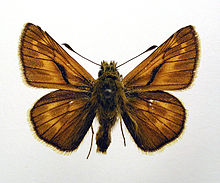- Large Skipper
-
Large Skipper 
Male 
Mounted Scientific classification Kingdom: Animalia Phylum: Arthropoda Class: Insecta Order: Lepidoptera Family: Hesperiidae Genus: Ochlodes Species: O. sylvanus Binomial name Ochlodes sylvanus
(Esper, 1777)
European part of range Synonyms Papilio sylvanus Esper, 1777
Papilio melicerta Bergsträsser, 1780
Augiades venata faunus Turati, 1905
Ochlodes venata faunus (Turati, 1905)
Ochlodes alexandra Hemming, 1934
Ochlodes esperi Verity, 1934The Large Skipper (Ochlodes sylvanus) is a butterfly of the Hesperiidae family, which occurs throughout Europe. It was long known as Ochlodes venata, but this is a Far Eastern relative. There is still some dispute whether this species should be considered a distinct species or included in O. venata as a subspecies.
Contents
Appearance, behaviour and distribution
This butterfly's range extends throughout Europe to northern Asia, China and Japan. In the British Isles it occurs in England, Wales, and south western Scotland. Although called 'Large' this is still a relatively small butterfly and not much larger than either the Small or Essex Skippers. The faint chequered pattern on both the upperside and underside help to distinguish the Large Skipper from these two orange Skippers. It can be found anywhere where wild grasses are allowed to grow tall. Hedgerows, woodland clearings and edges are favourites. An active little butterfly in sunny weather it is attracted to various flowers but has a distinct liking for Bramble flowers
Life Cycle and foodplants
Eggs are laid singly on the underside of foodplant leaves and hatch after about two weeks. They are normally laid on Cocksfoot Dactylis glomerata but they will occasionally use Purple Moor-grass Molinia caerulea, False Brome Brachypodium sylvaticum, Tor-grass B. pinnatum and Wood Small-reed Calamagrostis epigejos. On hatching the larvae construct a shelter in the usual skipper method of curling a leaf up with silk and begins to feed. It hibernates as a half-grown caterpillar and emerges in the spring to continue feeding and growing. The caterpillar has a large blackish-brown head with a dark line down its back and a yellow stripe along each side. Pupation lasts about three weeks during May and June and the adults are present from June to August. It is the first of the 'grass skippers' to emerge in the UK. In northern Europe the butterflies have a single brood, but in the south they may have up to three broods.
Gallery
See also
- List of butterflies of Great Britain
- List of butterflies in Sweden
References and external links
- Large Skipper page from Derbyshire butterflies
- Large Skipper page from UK Butterflies
- Large Skipper page from Natural History Collections of the University of Edinburgh
- Large Skipper page from Butterfly Conservation
- Shreeve, T.G.; Emmet, A.M. (1990), OCHLODES VENATA (Bremer & Grey). Pages 64–67 in Emmet, A.M., J. Heath et al. (Eds.) The Butterflies of Great Britain and Ireland. The Moths and Butterflies of Great Britain and Ireland Vol. 7 Part 1 (Hesperiidae to Nymphalidae), Harley Books, Colchester, UK. 370p.
- Jim Asher et al. The Millennium Atlas of Butterflies of Britain and Ireland. Oxford University Press.
Categories:- Hesperiini
- Butterflies and moths of Europe
- British butterflies
Wikimedia Foundation. 2010.




